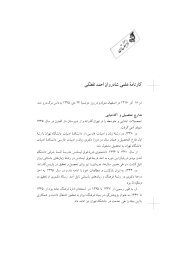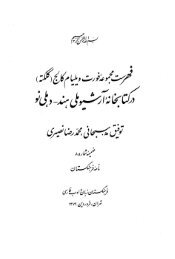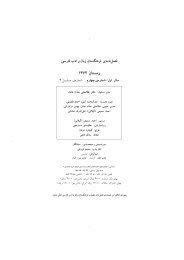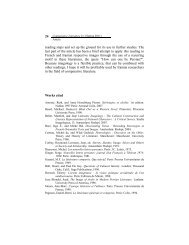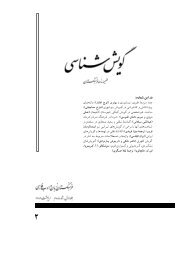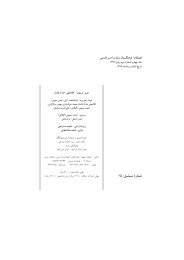The Shahnameh in Print The Lithographed Editions of the Persian ...
The Shahnameh in Print The Lithographed Editions of the Persian ...
The Shahnameh in Print The Lithographed Editions of the Persian ...
- No tags were found...
Create successful ePaper yourself
Turn your PDF publications into a flip-book with our unique Google optimized e-Paper software.
<strong>The</strong> <strong>Shahnameh</strong> <strong>in</strong> Pr<strong>in</strong>t<strong>The</strong> <strong>Lithographed</strong> <strong>Editions</strong> <strong>of</strong> <strong>the</strong> <strong>Persian</strong> National EpicUlrich Marzolph S<strong>in</strong>ce <strong>the</strong> time <strong>of</strong> its compilation, <strong>the</strong> <strong>Shahnameh</strong> for many centuries had exclusivelybeen produced <strong>in</strong> manuscript copies, many <strong>of</strong> which were adorned with magnificentillustrations. It was only at <strong>the</strong> beg<strong>in</strong>n<strong>in</strong>g <strong>of</strong> <strong>the</strong> n<strong>in</strong>eteenth century that pr<strong>in</strong>tedcopies <strong>of</strong> <strong>the</strong> <strong>Shahnameh</strong> were published. <strong>The</strong> new dimension <strong>of</strong> publish<strong>in</strong>g <strong>the</strong> text<strong>of</strong> <strong>the</strong> <strong>Persian</strong> national epic <strong>in</strong> pr<strong>in</strong>t was primarily due to <strong>the</strong> effort <strong>of</strong> Britishcolonialist scholars <strong>in</strong> India. Mat<strong>the</strong>w Lumsden (1777–1835), pr<strong>of</strong>essor <strong>of</strong> Arabicand <strong>Persian</strong> at <strong>the</strong> College <strong>of</strong> Fort William and one <strong>of</strong> <strong>the</strong> most prolific Europeanscholars <strong>of</strong> <strong>Persian</strong> <strong>of</strong> his day, started a projected complete edition <strong>of</strong> Firdausi’s epicpoem <strong>in</strong> eight volumes, but only managed to publish <strong>the</strong> first volume <strong>in</strong> 1811. <strong>The</strong>first complete edition <strong>of</strong> <strong>the</strong> <strong>Shahnameh</strong> was achieved by Major Turner Macan, wholater earned fame for br<strong>in</strong>g<strong>in</strong>g <strong>the</strong> manuscript <strong>of</strong> <strong>the</strong> Thousand and One Nights toIndia that served as <strong>the</strong> basis <strong>of</strong> this work’s subsequent edition by William HayMacnaghten. In 1829 Macan’s edition <strong>of</strong> <strong>the</strong> <strong>Shahnameh</strong> was published <strong>in</strong> fourvolumes <strong>in</strong> Calcutta. Besides this editio pr<strong>in</strong>ceps, o<strong>the</strong>r n<strong>in</strong>eteenth century editionswere published by Jules Mohl (Paris, 1838–1878) and Johann August Vullers(Leiden, 1877–1879). Meanwhile, <strong>the</strong> vast majority <strong>of</strong> <strong>the</strong> <strong>Shahnameh</strong>’s earlyeditions were produced <strong>in</strong> India and Iran by way <strong>of</strong> lithography.<strong>The</strong> Pr<strong>in</strong>t<strong>in</strong>g <strong>of</strong> Books <strong>in</strong> India and IranIn India, as <strong>in</strong> Iran, <strong>the</strong> art <strong>of</strong> pr<strong>in</strong>t<strong>in</strong>g as a permanent cultural practice was onlyestablished <strong>in</strong> <strong>the</strong> early decades <strong>of</strong> <strong>the</strong> n<strong>in</strong>eteenth century. Pr<strong>in</strong>t<strong>in</strong>g from movabletype (typography) had been <strong>the</strong> first technique to be <strong>in</strong>troduced. Hav<strong>in</strong>g been usedby <strong>the</strong> Orientalist pr<strong>in</strong>t<strong>in</strong>g houses <strong>in</strong> India and elsewhere for some time, thistechnique, however, did not yield satisfactory results and was only successfultowards <strong>the</strong> end <strong>of</strong> <strong>the</strong> n<strong>in</strong>eteenth century. Meanwhile, towards <strong>the</strong> end <strong>of</strong> <strong>the</strong>eighteenth century, Prague citizen Alois Senefelder had <strong>in</strong>vented <strong>the</strong> process <strong>of</strong>lithographic pr<strong>in</strong>t. This technique soon became extremely popular <strong>in</strong> India and Iran, Enzyklopädie des Mrchens Gött<strong>in</strong>gen Universität
10<strong>The</strong> Subcont<strong>in</strong>entEssays<strong>in</strong>ce it permitted <strong>the</strong> production <strong>of</strong> pr<strong>in</strong>ted items with relatively simple technicalmeans and at comparatively low cost. In <strong>the</strong> process <strong>of</strong> pr<strong>in</strong>t<strong>in</strong>g <strong>Persian</strong> books byway <strong>of</strong> lithography, <strong>the</strong> item to be pr<strong>in</strong>ted – whe<strong>the</strong>r text, illum<strong>in</strong>ation, or illustration– was first prepared on a sheet <strong>of</strong> special transfer paper to which <strong>the</strong> special <strong>in</strong>k usedwould not stick. <strong>The</strong> orig<strong>in</strong>al copy was <strong>the</strong>n used to pr<strong>in</strong>t a negative image onto <strong>the</strong>surface <strong>of</strong> <strong>the</strong> lithographic stone. After <strong>the</strong> stone had been treated with a weakaquafortis, <strong>the</strong> pr<strong>in</strong>t<strong>in</strong>g <strong>in</strong>k would only stick to those places that had previously beentouched by <strong>the</strong> writ<strong>in</strong>g <strong>in</strong>k. In this manner, a number <strong>of</strong> some 300 to 400 copiescould be pr<strong>in</strong>ted from any orig<strong>in</strong>al before <strong>the</strong> surface <strong>of</strong> <strong>the</strong> only exist<strong>in</strong>g negativeimage would wear out. <strong>The</strong> vast majority <strong>of</strong> items pr<strong>in</strong>ted <strong>in</strong> <strong>the</strong> <strong>Persian</strong> script <strong>in</strong>India, Iran, and Middle Asia were produced by way <strong>of</strong> lithography.Similar to fifteenth century <strong>in</strong>cunabula <strong>in</strong> Europe, <strong>the</strong> lithographic pr<strong>in</strong>t<strong>in</strong>g <strong>of</strong><strong>Persian</strong> texts at first resulted <strong>in</strong> <strong>the</strong> production <strong>of</strong> books whose formal conceptionand layout were more or less identical to those <strong>of</strong> manuscript tradition. Incomparison to items pr<strong>in</strong>ted from movable type, lithography had <strong>the</strong> particularadvantage <strong>of</strong> allow<strong>in</strong>g calligraphers, illum<strong>in</strong>ators and illustrators to work on <strong>the</strong> verysame surface. As a result, <strong>the</strong> books pr<strong>in</strong>ted by way <strong>of</strong> lithography were comparable<strong>in</strong> layout and appearance to <strong>the</strong> previous manuscripts.Western scholars have traditionally regarded <strong>the</strong> lithographed editions <strong>of</strong> classical<strong>Persian</strong> texts with a certa<strong>in</strong> disda<strong>in</strong>. In <strong>the</strong>ir op<strong>in</strong>ion, <strong>the</strong>se editions did not stand upto <strong>the</strong> criteria <strong>of</strong> critical scholarship. At best, <strong>the</strong>y would be regarded as ano<strong>the</strong>r“manuscript” version. <strong>The</strong>odor Nöldeke is one <strong>of</strong> <strong>the</strong> few scholars ever to discuss<strong>the</strong> lithographed editions <strong>of</strong> <strong>the</strong> <strong>Shahnameh</strong> <strong>in</strong> some detail. Even though he judges<strong>the</strong>se editions to be <strong>of</strong> comparatively little value for <strong>the</strong> purpose <strong>of</strong> textual critique,he admitted that <strong>the</strong>ir publishers had taken considerable effort and care <strong>in</strong> <strong>the</strong>irproduction.<strong>The</strong> First Pr<strong>in</strong>ted <strong>Editions</strong> <strong>of</strong> <strong>the</strong> <strong>Shahnameh</strong>In terms <strong>of</strong> text, <strong>the</strong> lithographed editions <strong>of</strong> <strong>the</strong> <strong>Shahnameh</strong> closely follow TurnerMacan’s editio pr<strong>in</strong>ceps. A certa<strong>in</strong> amount <strong>of</strong> variation may or may not result fromei<strong>the</strong>r lack<strong>in</strong>g care on <strong>the</strong> part <strong>of</strong> <strong>the</strong> calligraphers or from conscious editorialdecisions. Meanwhile, when evaluat<strong>in</strong>g <strong>the</strong> lithographed editions, one has to keep <strong>in</strong>m<strong>in</strong>d that <strong>the</strong> audience and, hence, <strong>the</strong> general editorial decisions <strong>of</strong> “Western” and“Oriental” editors differed widely. Western scholars prepar<strong>in</strong>g <strong>the</strong> <strong>Shahnameh</strong>’scritical editions took great care to establish a text that would aim be as close aspossible to <strong>the</strong> presumed orig<strong>in</strong>al while identify<strong>in</strong>g later textual <strong>in</strong>terference. <strong>The</strong>“Oriental” editors addressed <strong>the</strong> local audience <strong>of</strong> Indian and Iranian readers forwhom <strong>the</strong> <strong>Shahnameh</strong> constituted a highly admired work <strong>of</strong> classical literature. For<strong>the</strong>m, <strong>the</strong> <strong>Shahnameh</strong> was part <strong>of</strong> <strong>the</strong>ir traditional heritage and <strong>of</strong> cultural idenity.<strong>The</strong> “Oriental” readers, <strong>the</strong>n, were not so much concerned with <strong>the</strong> critical substance<strong>of</strong> <strong>the</strong> text. For <strong>the</strong>m, <strong>the</strong> possession <strong>of</strong> a personal copy <strong>of</strong> <strong>the</strong> <strong>Shahnameh</strong> had beena matter <strong>of</strong> honor and pride for long, yet most <strong>of</strong> <strong>the</strong>m would not have had <strong>the</strong>material means to afford commission<strong>in</strong>g a handwritten copy <strong>of</strong> <strong>the</strong> work or buy<strong>in</strong>gan already exist<strong>in</strong>g one. <strong>The</strong> pr<strong>in</strong>ted editions for <strong>the</strong> first time <strong>in</strong> history made <strong>the</strong>
<strong>The</strong> Subcont<strong>in</strong>entEssay11personal possession <strong>of</strong> <strong>the</strong> <strong>Shahnameh</strong> affordable. <strong>The</strong> “Oriental” readers would bequite satisfied, so long as <strong>the</strong> work conta<strong>in</strong>ed more or less what <strong>the</strong>y would expect itto conta<strong>in</strong> <strong>in</strong> terms <strong>of</strong> text. Of great importance to <strong>the</strong>m was, however, <strong>the</strong> work’sphysical presentation and appearance. This criterion applied first <strong>of</strong> all to anappeal<strong>in</strong>g calligraphy <strong>of</strong> <strong>the</strong> <strong>Persian</strong> nasta’liq script, as documented, for <strong>in</strong>stance, by<strong>the</strong> fact that <strong>the</strong> 1855 Indian edition written by <strong>the</strong> famous calligrapher Auliya’Sami‘ al-Shirazi was repr<strong>in</strong>ted <strong>in</strong> <strong>of</strong>fset technique several times. Moreover, <strong>the</strong>“Oriental” audience was well aware <strong>of</strong> <strong>the</strong> magnificent illustrated manuscripts <strong>of</strong> <strong>the</strong><strong>Shahnameh</strong> that had been produced for wealthy patrons <strong>in</strong> <strong>the</strong> course <strong>of</strong> history.Consequently, it was also a matter <strong>of</strong> cause that <strong>the</strong> work’s lithographed editionsshould be adorned by illustrations and graphic illum<strong>in</strong>ation. In this manner, <strong>the</strong>lithographed editions <strong>of</strong> <strong>the</strong> <strong>Shahnameh</strong> are works <strong>of</strong> art. In comparison with <strong>the</strong>magnificent products <strong>of</strong> <strong>the</strong> Timurid and Safavid eras with <strong>the</strong>ir splendid calligraphyand <strong>the</strong>ir overwhelm<strong>in</strong>g m<strong>in</strong>iatures, <strong>the</strong> lithographed <strong>Shahnameh</strong>s are probably not<strong>in</strong>tricate pieces <strong>of</strong> “great” art. On <strong>the</strong> contrary, as for <strong>the</strong>ir artistic quality, <strong>the</strong>y arefairly modest, and particularly <strong>the</strong> more recent Indian editions show signs <strong>of</strong> lack<strong>in</strong>gcare. <strong>The</strong> modest artistic quality <strong>of</strong> <strong>Persian</strong> lithographed illustrations should,however, by no means justify <strong>the</strong>ir disregard. <strong>Persian</strong> lithographed books <strong>of</strong>fer <strong>the</strong>charm<strong>in</strong>g simplicity <strong>of</strong> an art that, given its production <strong>in</strong> hundreds <strong>of</strong> copies,derives its significance from <strong>the</strong> fact that it was at least a little closer to <strong>the</strong> commonpeople than elite art serv<strong>in</strong>g <strong>the</strong> privileged. This social aspect might <strong>in</strong> <strong>the</strong> long runcontribute to an adequate understand<strong>in</strong>g <strong>of</strong> <strong>the</strong> art <strong>of</strong> <strong>the</strong> <strong>Persian</strong> book <strong>in</strong> <strong>the</strong> Qajarera.<strong>The</strong> <strong>Lithographed</strong> <strong>Editions</strong> <strong>of</strong> <strong>the</strong> <strong>Shahnameh</strong><strong>The</strong> exact number <strong>of</strong> lithographed editions <strong>of</strong> <strong>the</strong> <strong>Shahnameh</strong> rema<strong>in</strong>s unknown.Accord<strong>in</strong>g to <strong>the</strong> available bibliographical data, and start<strong>in</strong>g with <strong>the</strong> editionBombay 1846, probably some 30 lithographed Oriental editions <strong>of</strong> <strong>the</strong> <strong>Shahnameh</strong>were published, most <strong>of</strong> <strong>the</strong>m <strong>in</strong> Indian cities such as Bombay, Lucknow, andCawnpore. Only five lithographed editions <strong>of</strong> <strong>the</strong> <strong>Shahnameh</strong> were published <strong>in</strong> Iran<strong>in</strong> a period extend<strong>in</strong>g over half a century (1851 up to 1904) <strong>in</strong> Tehran and Tabriz.Contrast<strong>in</strong>g with this moderate production is <strong>the</strong> number <strong>of</strong> some 25 Indian editions<strong>of</strong> <strong>the</strong> <strong>Shahnameh</strong> that were published <strong>in</strong> <strong>the</strong> period <strong>of</strong> seventy years extend<strong>in</strong>g fromabout 1850 to 1920. <strong>The</strong> reason for this considerable difference <strong>in</strong> numbers <strong>of</strong>editions rema<strong>in</strong> obscure. Economical factors, such as <strong>the</strong> price <strong>of</strong> paper or <strong>the</strong> feesfor <strong>the</strong> employees <strong>in</strong>volved <strong>in</strong> <strong>the</strong> pr<strong>in</strong>t<strong>in</strong>g process, must have played a certa<strong>in</strong> role<strong>in</strong> determ<strong>in</strong><strong>in</strong>g <strong>the</strong> number <strong>of</strong> editions produced. Notably, <strong>the</strong> Indian editions did notonly, and maybe not even primarily, aim to satisfy local demand, s<strong>in</strong>ce a substantialamount <strong>of</strong> <strong>Persian</strong> books <strong>of</strong> Indian production were exported to Iran. One evenmight have to consider <strong>the</strong> vital importance <strong>the</strong> <strong>Shahnameh</strong> possessed for <strong>the</strong> Parsicommunities <strong>in</strong> India <strong>in</strong> relat<strong>in</strong>g <strong>the</strong>ir current position to <strong>the</strong> glorious past <strong>of</strong> <strong>the</strong>country <strong>the</strong>y once had orig<strong>in</strong>ated from. This assumption is corroborated by <strong>the</strong>image illustrat<strong>in</strong>g <strong>the</strong> scene <strong>in</strong> which Zoroaster founds <strong>the</strong> religion <strong>of</strong> Zoroastrianismby hand<strong>in</strong>g over <strong>the</strong> sacred fire. Quite understandably, this illustration is rarely
12<strong>The</strong> Subcont<strong>in</strong>entEssayconta<strong>in</strong>ed <strong>in</strong> <strong>the</strong> <strong>Shahnameh</strong> manuscripts that were produced at <strong>the</strong> order <strong>of</strong> <strong>the</strong> greatMoslem rulers. Meanwhile, it forms part <strong>of</strong> <strong>the</strong> standard repertoire <strong>of</strong> all <strong>the</strong> work’slithographed editions, notably both <strong>the</strong> Indian and <strong>the</strong> Iranian ones. <strong>The</strong> later Indianeditions came to be <strong>of</strong> an <strong>in</strong>creas<strong>in</strong>gly modest quality both <strong>in</strong> terms <strong>of</strong> physicalappearance and care <strong>in</strong>vested <strong>in</strong>to <strong>the</strong> production <strong>of</strong> <strong>the</strong> text as well as <strong>the</strong>illustrations. <strong>The</strong> last lithographed edition <strong>of</strong> <strong>the</strong> <strong>Shahnameh</strong> prepared <strong>in</strong> India isprobably <strong>the</strong> edition published <strong>in</strong> Cawnpore <strong>in</strong> 1919.<strong>The</strong> first lithographed edition <strong>of</strong> <strong>the</strong> <strong>Shahnameh</strong> conta<strong>in</strong>s a set <strong>of</strong> 57 illustrations.Similar to o<strong>the</strong>r illustrated works <strong>of</strong> <strong>Persian</strong> literature, this number <strong>of</strong> pr<strong>in</strong>ts set <strong>the</strong>standard for all <strong>of</strong> <strong>the</strong> lithographed editions to follow. Most <strong>of</strong> <strong>the</strong> later illustrationsei<strong>the</strong>r constitute relatively faithful copies <strong>of</strong> <strong>the</strong> earlier items or are at least <strong>in</strong>spiredby <strong>the</strong>ir model; only rarely were new illustrations <strong>in</strong>serted <strong>in</strong>to <strong>the</strong> repertoire. Froman artistic po<strong>in</strong>t <strong>of</strong> view, <strong>the</strong> lithographed editions <strong>of</strong> <strong>the</strong> <strong>Shahnameh</strong> produced <strong>in</strong>India display a peculiar character. This peculiar character relates to both calligraphyand illustration. <strong>The</strong> calligraphy applied is usually a well-written nasta’liq thatdocuments <strong>the</strong> pr<strong>of</strong>essional background <strong>of</strong> <strong>the</strong> calligraphers, mostly mention <strong>the</strong>irname. <strong>The</strong> only calligrapher enjoy<strong>in</strong>g some renown is <strong>the</strong> one known as Ouliya’Sami’, who prepared <strong>the</strong> calligraphy for <strong>the</strong> editions <strong>of</strong> Bombay 1272/1855 and1276/1859. Particularly, <strong>in</strong> <strong>the</strong> more recent editions, <strong>the</strong> calligraphy betrays <strong>the</strong>characteristics <strong>of</strong> Indian nasta’liq style that is somewhat less smooth and flow<strong>in</strong>gthan <strong>the</strong> style practiced <strong>in</strong> Iran.As for <strong>the</strong> illustrations, most <strong>of</strong> <strong>the</strong> artists who prepared <strong>the</strong>m rema<strong>in</strong> unknown. <strong>The</strong>few illustrators known by name are ‘Ali Akbar (Bombay 1266/1849), SeyyedMohammad Mirza Kazem al-Hose<strong>in</strong>i al-Shirazi (Bombay 1276/1859), and Vazir‘Ali and Qasem ‘Ali Mosavver (Cawnpore 1290/1874). Both <strong>of</strong> <strong>the</strong> two earlyeditions (Bombay 1262/1846 and 1266/1849) betray a fairly crude and simple stylethat is somewhat rem<strong>in</strong>iscent <strong>of</strong> <strong>the</strong> Kashmiri style <strong>of</strong> manuscript illum<strong>in</strong>ation. <strong>The</strong>illustrations <strong>of</strong> <strong>the</strong> later editions are not devoid <strong>of</strong> a certa<strong>in</strong> attraction <strong>in</strong> terms <strong>of</strong>composition and diligence <strong>of</strong> execution. A typical characteristic <strong>of</strong> <strong>the</strong> Indianillustrations is <strong>the</strong> <strong>in</strong>dication <strong>of</strong> landscape by parallel l<strong>in</strong>es. It is <strong>in</strong>terest<strong>in</strong>g to notethat <strong>the</strong> two early Indian editions apparently founded two different iconographicalschools. <strong>The</strong> first and <strong>the</strong> second Iranian edition follow <strong>the</strong> iconographical program<strong>of</strong> <strong>the</strong> first Indian edition while <strong>the</strong> third and fourth Iranian edition take <strong>the</strong> secondIndian edition as <strong>the</strong>ir model. Meanwhile, one has to keep <strong>in</strong> m<strong>in</strong>d that it is notjustified to draw a clear l<strong>in</strong>e <strong>of</strong> dist<strong>in</strong>ction between <strong>the</strong> “Indian” and <strong>the</strong> “Iranian”editions. After all, a large number <strong>of</strong> <strong>the</strong> editors, calligraphers, and artistscollaborat<strong>in</strong>g <strong>in</strong> <strong>the</strong> publication <strong>of</strong> <strong>Persian</strong> texts <strong>in</strong> India were <strong>of</strong> <strong>Persian</strong>, <strong>of</strong>ten <strong>of</strong>Shirazi, orig<strong>in</strong>. Besides, a certa<strong>in</strong> quantity <strong>of</strong> books <strong>of</strong> Indian production wasundoubtedly produced for Iranian customers. <strong>The</strong> extent <strong>of</strong> this <strong>in</strong>ternationalcooperation, its mechanisms and consequences rema<strong>in</strong> to be studied. At any rate,India was and rema<strong>in</strong>ed <strong>the</strong> major production site for <strong>the</strong> lithographed editions <strong>of</strong> <strong>the</strong><strong>Persian</strong> national epic.
<strong>The</strong> Subcont<strong>in</strong>entEssay13A List<strong>in</strong>g <strong>of</strong> <strong>Lithographed</strong> Indian <strong>Editions</strong> <strong>of</strong> <strong>the</strong> <strong>Shahnameh</strong>1. 1262/1846 Bombay; size 21.5 x 31.5 cm, written space 14.5 x 24 cm, 4 columns,27 l<strong>in</strong>es; calligraphy by Reza al-Hosa<strong>in</strong>i al-Shirazi; 57 illustrations by ananonymous artist; published by Mohammad Mahdi Esfahani2. 1266/1849 Bombay; size 19.5 x 29 cm, written space 14.2 x 23.9 cm, 4 columns,27 l<strong>in</strong>es; calligraphy by Reza ibn Ahmad al-Hosa<strong>in</strong>i al-Shirazi; 57 illustrationsby ‘Ali Akbar; published by Mohammad Baqer Shirazi3. 1270/1853 Bombay; calligraphy by Aqa Baba4. 1272/1855 Bombay (photomechanical repr<strong>in</strong>t Bombay 1331/1913); size 25.5 x35.5 cm, written space 19.5 x 30 cm, 6 columns, 33 l<strong>in</strong>es; calligraphy byMohammad Ebrahim ibn Mohammad Hosa<strong>in</strong> Khan Ouliya’ Sami‘ al-Shirazi; 58illustrations by Mohammad ibn Mirza Kazem al-Hosa<strong>in</strong>i al-Shirazi; piblished byMohammad-Baqer Shirazi5. 1274/1857 Cawnpore6. 1274–75/1857–58 Bombay; size 38.5 x 25.5 cm, written space 19.5 x 32 cm, 6columns, 37 l<strong>in</strong>es; calligraphy by ‘Abdalkarim ibn Mohammad Ebrahim al-Tabataba’i al-Esfahani al-Ardestani, Mohammad ibn ‘Abdallah al-Shirazi;published by Mohammad Sadeq Shirazi7. 1275–76/1858–59 Bombay; size 21 x 31 cm, written space 16.5 x 27.5 cm, 6columns, 37 l<strong>in</strong>es; calligraphy by ‘Abd al-Karim ibn Mohammad Ebrahim al-Tabataba’i al-Esfahani al-Ardestani, Mirza Mohammad Reza ibn AqaMohammad Hosa<strong>in</strong> Shirazi; published by Mirza Baqer ibn Mirza KuchekShirazi8. 1275/1858 Bombay; calligraphy by Mirza Mohammad ibn Mirza ‘Ali TabibShahid-e Shirazi9. 1276/1859 Bombay; size 22.5 x 33 cm, written space 16.5 x 26 cm, 6 columns,32 l<strong>in</strong>es; calligraphy by Mohammad Ebrahim ibn Mohammad-Hosa<strong>in</strong> KhanOuliya’ Sami‘; 56 illustrations by Mohammad ibn Mirza Kazem al-Hose<strong>in</strong>i al-Shirazi10. 1279/1862 India11. 1284/1867 Lucknow12. 1287/1870 Lucknow; size 26.5 x 41 cm, written space 22 x 36 cm, 6 columns,37 l<strong>in</strong>es; calligraphy by Janki Parshad; publisher Newal Kishor13. 1290/1874 Cawnpore14. 1291/1875 Cawnpore15. 1298–1300/1881–1883 Bombay; calligraphy by Mirza ‘Ali-Khan al-Fasavi;publisher Heidari
14<strong>The</strong> Subcont<strong>in</strong>entEssay16. 1301/1884 Lucknow; size 30 x 19.5 cm; publisher Newal Kishor17. 1306–1308/1888–1890 Bombay; size 23 x 32 cm, written space 18 x 27.5 cm, 6columns, 37 l<strong>in</strong>es; calligraphy by Seyyid Nazem-Hose<strong>in</strong> Razavi Muhani;published by Qazi ‘Abd al-Karim ibn Qazi Nur-Mohammad, Qazi Fath-Mohammad; publisher Fath al-Karim18. 1308–1315/1890–1898 Bombay; size 24.5 x 33 cm, written space 18.5 x 28 cm,6 columns, 37 l<strong>in</strong>es; calligraphy by Mir Baraqani Mortaza al-Hosa<strong>in</strong>i, ‘Ali-Rezaibn Abu l-Hasan ibn Mirza Aqa; published by Aqa Mirza EbrahimShirazi;publisher Naderi19. 1314/1897 Cawnpore; size 31.5 cm; publisher Newal Kishor20. 1315/1898 Bombay; publisher A’<strong>in</strong>e-ye Khorshid21. 1321/1903 Bombay22. 1326/1909 Cawnpore; size 21 x 32.5 cm; publisher Newal Kishor23. 1338/1919 CawnporeBibliography Marzolph, Ulrich, Narrative Illustration <strong>in</strong> <strong>Persian</strong> <strong>Lithographed</strong> Books, Leiden, 2001. Marzolph, Ulrich, “Illustrated <strong>Persian</strong> Lithographic <strong>Editions</strong> <strong>of</strong> <strong>the</strong> <strong>Shahnameh</strong>”,Edebiyat, 13,2 (2002) 177–198. Nöldeke, <strong>The</strong>odor, “Das iranische Nationalepos”, Grundriß der iranischen Philologie,vol. 2. ed. by Wilhelm Geiger and Ernst Kuhn. Strassburg, 1986–1904, pp. 130–211. Scheglova, Olimpiada P, “Lithograph versions <strong>of</strong> <strong>Persian</strong> manuscripts <strong>of</strong> Indian manufacture<strong>in</strong> <strong>the</strong> n<strong>in</strong>eteenth century”, Manuscripta Orientalia, 5,1 (1999) 12–22. Van Zutphen, Marjolijn, “<strong>Lithographed</strong> <strong>Editions</strong> <strong>of</strong> Frdaws’s Shhnam: AComparative Study. In: Oriens, 37 (2009) 65–101..1390 1385 .1384--




